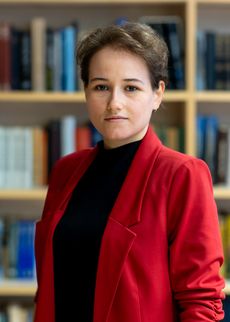Extracellular and Sarcomeric Alterations in Marfan Syndrome - home PhD-defense of Cristina M. Șulea - 11 Sept 2015, 15:00
2025. szeptember 9
Workplace defense place and time: Department of Biophysics and Radiation Biology, September 11th, 2025, 15:00
Title: Extracellular and Sarcomeric Alterations in Marfan Syndrome: Insights from Aortic Fibrillin-1 and Myocardial Titin Investigations
Candidate: Cristina M. Șulea, MD
Supervisors: Prof. Miklós Kellermayer DSc, Dr. Med. Habil., Prof. Zoltán Szabolcs PhD, Dr. Med. Habil.
 Summary: Marfan syndrome (MFS) is an autosomal dominant connective tissue disorder caused by pathogenic variants in the FBN1 gene, which encodes fibrillin-1, the core component of extracellular microfibrils. In the aortic wall, these structures are critical for maintaining structural integrity and bearing mechanical loads. FBN1 mutations are expected to impact the function of fibrillin-1 microfibrils, thereby contributing to the main manifestations of MFS, namely progressive aortic aneurysm and dissection, which remain the leading causes of morbidity and mortality in affected individuals. In addition to aortic involvement, growing evidence suggests that MFS may also involve an intrinsic form of cardiomyopathy, a condition typically linked to the sarcomeric protein titin. These observations highlight the need for a deeper molecular understanding of how FBN1 variants translate into structural and functional alterations within cardiovascular tissues.
Summary: Marfan syndrome (MFS) is an autosomal dominant connective tissue disorder caused by pathogenic variants in the FBN1 gene, which encodes fibrillin-1, the core component of extracellular microfibrils. In the aortic wall, these structures are critical for maintaining structural integrity and bearing mechanical loads. FBN1 mutations are expected to impact the function of fibrillin-1 microfibrils, thereby contributing to the main manifestations of MFS, namely progressive aortic aneurysm and dissection, which remain the leading causes of morbidity and mortality in affected individuals. In addition to aortic involvement, growing evidence suggests that MFS may also involve an intrinsic form of cardiomyopathy, a condition typically linked to the sarcomeric protein titin. These observations highlight the need for a deeper molecular understanding of how FBN1 variants translate into structural and functional alterations within cardiovascular tissues.
We examined the ultrastructure and nanomechanical properties of individual fibrillin-1 microfibrils isolated from aortic tissue of MFS patients and non-MFS controls. Atomic force microscopy revealed a preserved microfibrillar appearance but significant morphological changes in MFS samples, where microfibrils exhibited a more fragile structure. Force spectroscopy showed a reduction in microfibrillar stiffness in MFS patients carrying haploinsufficient FBN1 variants. Indentation-like features in the force-distance curves, interpreted as localized mechanical failure, appeared at significantly lower forces in MFS microfibrils, emphasizing their mechanical fragility.
In parallel, we assessed titin expression within the left ventricular myocardium of MFS patients. Proteomic profiling revealed a shift toward the more compliant N2BA isoform in MFS patients, without a change in total titin content. This change may represent an adaptive response to the extracellular matrix alterations characteristic of MFS, aimed at preserving diastolic function through reduced myocardial stiffness.
In summary, our findings provide a detailed characterization of the molecular and mechanical consequences of FBN1 mutations in the human aorta and myocardium. The results indicate that aortic fibrillin-1 microfibrils are structurally and mechanically compromised in MFS, while sarcomeric remodeling in the left ventricular myocardium occurs even in the absence of overt valvular disease, suggesting a broader compensatory response to altered mechanical homeostasis in this condition.

